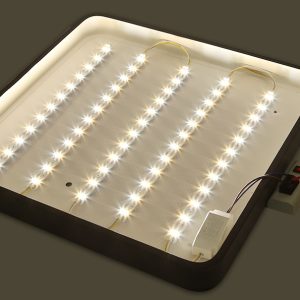LED circuit design, to better solve the heat dissipation problem, LEDs and some high-power ICs need to use aluminum-based printed circuit boards. Aluminum PCB includes a circuit layer (copper foil layer), an insulation layer, and a metal base. The circuit layer should have a large current-carrying capacity, so thick copper foil should be used, and its thickness is usually 35μm~280μm; the insulation layer is the core technology of the aluminum PCB substrate. It usually consists of special polymers filled with special ceramics with small heat resistance, good viscoelasticity, heat aging resistance, and resistance to mechanical and thermal stress.
IMS-H01, the insulating layer of high-performance PCB aluminum substrates such as IMS-H02 and LED-0601, uses this technology to give it excellent thermal conductivity and high-strength electrical insulation properties. The metal substrate is the supporting member of the aluminum base, which requires high thermal conductivity. Typically, it is an aluminum PCB. it is also possible to use copper (which provides better thermal conductivity). It is suitable for conventional processing such as drilling, punching, shearing, and cutting. Surface treatment: HAL, immersion gold, OSP, gold plating, HAL lead-free.

Insulation deterioration, component damage, thermal aging of materials, cracking of low melting point solder joints, solder joint detachment; Temperature effects on components: in general, an increase in temperature reduces the resistance, high temperatures reduce the service life of capacitors, and high temperatures degrade the performance of transformer choke insulating materials; in general, the permissible temperature of chokes is lower than 95 ℃, and when the IMC is too thick and the solder joints are brittle and mechanically weakened, the structure of the solder joints will change. The increase in junction temperature causes a rapid increase in the current amplification of the transistor, leading to an increase in collector current and a further increase in junction temperature, which ultimately leads to module failure. The purpose of aluminum thermal design is to control the temperature of all electronic components within the product so that it does not exceed the maximum temperature specified in the standards and specifications for the operating environment. aluminum core PCB
degrees. The calculation of the maximum allowable temperature should be based on a stress analysis of the components and be consistent with the reliability requirements of the product and the failure rate assigned to each component. The thermal design of LEDs is generally based on fluid dynamics software simulation and basic design. First, the resistance of fluid flow: due to the effect of fluid viscosity and the effect of solid boundaries, the fluid is subject to resistance in the flow process, this resistance is called flow resistance, and can be divided into two kinds: along the flow resistance and local resistance; Second, the resistance along the route: the frictional resistance of the fluid in the region of the boundary constant along the entire flow; Third, the local resistance: the frictional resistance in the region of the boundary changes sharply, such as in the
Boundary sharp changes in the region, such as the sudden expansion or sudden contraction of the cross-section, the elbow of the local position, are caused by rapid changes in the fluid state of the fluid flow resistance.
Usually, LEDs use heat sinks to dissipate heat naturally. Design steps of heat sink:
1. design the contour of the heat sink according to the relevant constraints.
2. Optimize the tooth thickness, tooth shape, tooth pitch, and substrate thickness of the heat sink according to the relevant design criteria of the heat sink. The design method of the radiator takes into account that the temperature boundary layer is thicker in natural cooling, if the tooth spacing is too small, the thermal boundary layer of the two teeth is easy to cross, which affects the convection of the tooth surface, so in general, it is recommended that the tooth spacing of the natural radiator is more than 12 mm. if the tooth height of the radiator is less than 10 mm, the tooth spacing of the radiator can be determined by the tooth spacing ≥ 1.2 tooth height.
3. the heat transfer capacity of the surface of a naturally cooled radiator is weak. increased corrugation on the surface of the radiator will not have a significant impact on the effect of natural convection, therefore it is recommended that corrugated teeth are not added to the corrugated Radiator surface.
4. natural convection on the radiator surface is usually darkened to increase the radiation coefficient of the radiator surface and enhance radiant heat transfer. 5. As natural convection reaches thermal equilibrium over a long period, the thickness of the base plate and teeth of the natural convection radiator should be sufficient to resist the effects of transient thermal loads, and it is recommended that the thickness of the natural convection radiator should be greater than 5mm.
In summary, the aluminum substrate has excellent electrical properties, heat dissipation capacity, electromagnetic shielding, high dielectric strength, and resistance to bending, widely used in high-power LED lighting, power supply, TV backlighting, automotive, computers, and many other industries, air conditioning inverter module, avionics, telecommunications, medical, audio and so on. When it comes to the most commonly used cell phone cameras, aluminum PCBs are an important part of the phone. As a kind of Metal Core PCB (MCPCB), Aluminum PCB has a lot of similarities with FR4 PCB in terms of manufacturing process or technology, such as thick copper foil etching, aluminum surface etching protection, aluminum plate fabrication, and solder mask printing.
Contact OPCBA.COM to inquire and fabricate your aluminum core PCB.

分享到: